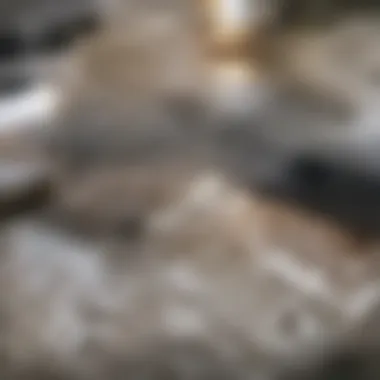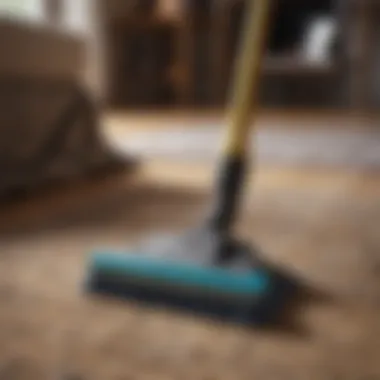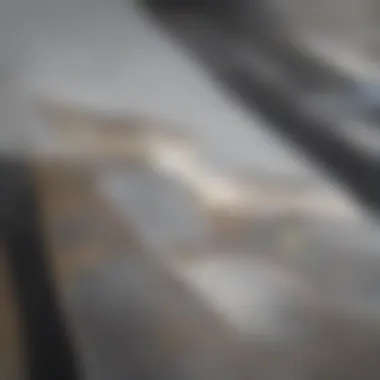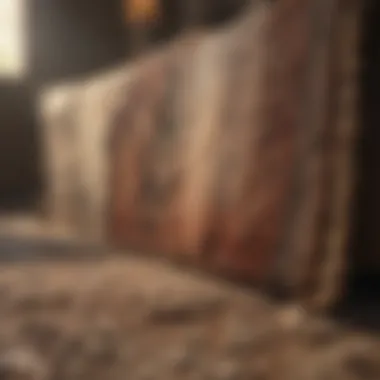The Ultimate Guide to Cleaning Plush Area Rugs


Intro
Cleaning plush area rugs is a critical aspect of maintaining both their aesthetic appeal and longevity. These luxurious textiles often become focal points in interiors, adding warmth and texture to spaces. However, they are also susceptible to dirt, stains, and wear. Understanding how to care for these rugs is essential for anyone who invests in them. This guide aims to provide a thorough understanding of the cleaning processes, tools needed, and possible challenges faced when dealing with plush area rugs.
The following sections will discuss various cleaning methods, how to spot clean effectively, the importance of routine maintenance, and deep cleaning options. Additionally, preventive care strategies will be highlighted to ensure your plush rugs remain beautiful for years to come.
Understanding Plush Area Rugs
Understanding plush area rugs is essential for maintaining both their beauty and functionality. These rugs can transform a space, adding warmth and elegance. They require specific care techniques to ensure lasting quality. Equipped with the right knowledge, a buyer or owner can prevent damage, extend the rug's life, and keep it looking fresh.
Defining Plush Area Rugs
Plush area rugs are characterized by their soft, thick pile. This thick pile creates a luxurious feeling underfoot. They are usually made to provide comfort and aesthetic appeal in residential and commercial spaces. The term "plush" refers to the rug's density and texture, which results in a velvety appearance. Commonly used in living rooms and bedrooms, these rugs can vary in size, color, and design. Their design can complement various interior styles, from modern to traditional.
Common Materials and Their Properties
Plush area rugs can be made from various materials, each having unique properties. Common materials include:
- Wool: Known for its durability and resilience, wool feels soft and is naturally stain resistant. It also has insulating properties.
- Polyester: This synthetic fiber is easy to clean. It can mimic the feel of natural fibers and is less expensive.
- Nylon: A strong synthetic option that resists abrasion and fading. This material can stand heavy foot traffic.
- Cotton: Soft and breathable, but less resilient compared to wool or synthetic fibers. It is usually more suitable for low-traffic areas.
- Silk: The luxurious feel of silk rugs comes at a higher price, as they require special care. They are not as durable as other materials.
Understanding these materials helps homeowners choose the right plush rug for their needs based on factors such as durability, cleaning requirements, and budget.
Benefits of Plush Area Rugs
Plush area rugs offer several advantages. They enhance comfort by providing a soft surface to walk on. This is especially beneficial in homes with children or elderly individuals. Additionally, plush rugs can improve interior aesthetics. They add color and texture, making spaces feel more inviting. Furthermore, these rugs can help with acoustics by absorbing sound, which can be ideal in apartments or busy homes.
- Comfort: A plush rug feels good underfoot, making it a popular choice for living spaces.
- Aesthetic Appeal: They enhance the overall decor, serving as a focal point or complementing existing elements.
- Sound Dampening: Their thick pile helps reduce noise, contributing to a quieter environment.
Assessing Your Rug’s Condition
Assessing the condition of your plush area rug is a crucial step before undertaking any cleaning process. Knowing the state of your rug can help determine the most effective methods for cleaning and maintaining it. It can prevent further damage and ensure that the rug continues to enhance the aesthetics of your space. Identifying specific issues like stains, wear, or odors can save time and money in the long run.
Identifying Stains and Damage
Begin by examining your rug for stains or damage. Different substances can affect the fabric in various ways. Watermarks, food spills, or even pet accidents can leave behind residues that may require distinct cleaning techniques. Carefully inspect the entire surface and check for any discoloration or fading, as these can indicate deeper issues.
Stains can be categorized into two types: absolute and potential.
- Absolute stains have established themselves. These may require deep cleaning methods.
- Potential stains are fresh and can often be treated easily before they set.
Using natural light can help you spot these imperfections more easily, allowing you to tackle them before they worsen.
Understanding Wear Patterns
After identifying stains, consider the wear patterns on your plush rug. Over time, foot traffic and environmental factors can cause certain areas to show more wear compared to others. Pay attention to the following:
- High Traffic Areas: Spots that see frequent use may become flattened or discolored quicker than others.
- Natural Fading: Sunlight can cause colors to fade in specific areas. The placement of your rug could be significant in preserving its appearance.
- Texture Changes: Note any alterations to the rug's texture, which can suggest significant wear or damage.
Understanding these wear patterns not only guides your cleaning strategy but can also inform decisions on where to place your rug for optimal longevity.
Choosing the Right Time for Cleaning
Timing is essential when it comes to cleaning plush area rugs. Seasonal factors, household events, and the rug's specific condition can dictate the best times for deep cleaning or maintenance routines. Watch for the following cues to initiate cleaning:
- Post-Event Cleaning: After hosting gatherings, stains and increased dirt often necessitate a cleaning.
- Seasonal Changes: Spring and fall are generally ideal for deep cleaning due to lower humidity levels, which help in drying.
- Regular Check-Ins: Establish a routine check every few months to assess the condition of your rug.


By being observant about your rug's condition and knowing when to act, you can maintain its beauty and functionality effectively. Regular assessments can significantly enhance the lifespan of your plush area rugs.
Basic Maintenance Strategies
Maintaining plush area rugs is essential for preserving their beauty and extending their lifespan. Regular attention to cleaning and upkeep can prevent significant wear and tear, keeping your rugs in good condition. Basic maintenance strategies involve routine practices that help minimize dirt buildup and damage. Implementing these practices will also reduce the need for extensive cleaning later on, saving time and resources.
Regular Vacuuming Techniques
Vacuuming is a fundamental step in rug maintenance. Frequent vacuuming removes dust, dirt, and allergens that accumulate in the fibers. For plush rugs, a vacuum with adjustable height settings is ideal to avoid damaging the delicate pile. Use a vacuum that has a beater bar that can be turned off to prevent snagging. Aim to vacuum in several directions to ensure all dirt is lifted.
- Set your vacuum on the highest setting.
- Vacuum slowly to allow the machine to effectively lift dirt.
- For high-pile rugs, do this at least once a week.
In addition to regular vacuuming, spot cleaning any surface spills as soon as they occur will help maintain the rug's appearance.
Preventing Dirt and Debris Buildup
Taking proactive steps to minimize dirt and debris is crucial for maintaining rugs. Placing doormats at entry points can significantly reduce the amount of dirt tracked onto your plush rug. Encourage guests to remove their shoes before entering, and ensure you have a cleaning routine for your floors to avoid transferring dirt.
Also, consider using an air purifier in the room where the rug is kept, as this will help minimize dust particles in the air that can settle on the rug.
Using Rug Pads for Longevity
Rug pads serve multiple purposes that contribute to the longevity of plush area rugs. Primarily, they provide a buffer between the rug and the floor, preventing friction, which can lead to wear. Rug pads also add an extra layer of cushioning, enhancing comfort underfoot. Furthermore, they can help keep the rug in place, preventing slippage that can lead to accidents.
When selecting a rug pad, look for one made of breathable materials to promote airflow and avoid moisture buildup beneath the rug. This is particularly important in spaces with high humidity.
In summary, basic maintenance strategies are fundamental for the care and longevity of plush area rugs. Implementing regular vacuuming, preventing dirt accumulation, and using rug pads are practical measures that ensure the rugs remain beautiful and functional.
"Effective maintenance can significantly extend the life of your plush area rug, allowing it to remain a focal point of your decor for years to come."
Incorporating these practices into your home routine will yield noticeable improvements in the appearance and feel of your plush rugs.
Spot Cleaning Techniques
Spot cleaning is an essential aspect in maintaining the beauty and extend the life of plush area rugs. It allows for immediate action against spills and stains, preventing these mishaps from becoming permanent fixtures on your rug. Proper spot cleaning techniques not only preserve the aesthetic appeal of the rug but also maintain hygiene by removing contaminants before they settle deep into the fibers. The key is to act quickly and efficiently when a spill occurs.
Gathering Essential Cleaning Supplies
Before proceeding with spot cleaning, it is crucial to have the right supplies on hand. Essential tools include:
- Blotting cloths: Use absorbent materials like microfiber cloths for maximum efficacy.
- Plain water: Sometimes, clean water is enough to address mild stains.
- Mild detergent: A pH-neutral cleaner helps to avoid rug damage.
- Stain removers: Choose specific stain removers designed for plush fibers, ensuring they are safe for your rug's material.
- Spray bottles: For easy application of water or detergent mixtures.
Having these supplies ready and accessible will make the spot cleaning process smoother and more effective.
Methods for Different Stains
Spot cleaning techniques vary depending on the type of stain. Here are popular approaches:
Dealing with Food Stains
When it comes to food stains, time is of the essence. The method involves blotting up any excess food immediately, followed by applying a mild detergent mixed with water. The key characteristic of this method is its simplicity. You need few supplies, and it’s effective for various food substances. The unique feature is the detergent, which helps to break down grease and residue from foods like sauces, chocolate, or drinks. One potential downside is that some colors from food can be stubborn, requiring persistence.
Addressing Pet Accidents
Addressing pet accidents is both crucial and sensitive. The first step is to remove as much of the material as possible, followed by blotting with clean water to dilute any remaining waste. It is vital to use an enzyme cleaner specifically designed for pet messes, which work by breaking down organic matter. This method is popular due to its effectiveness in removing odors and stains. However, be cautious about using products that may be too harsh for your rug material, as they can discolor or damage fibers.
Removing Grease and Oil


Removing grease and oil requires a unique approach. Similar to food stains, start by blotting the area to absorb excess oil. A key characteristic of this stain removal technique is the use of cornstarch or baking soda. These powders can absorb the oil when left for a few hours before vacuuming them up. This method works effectively but may require multiple applications, especially for larger grease spots. It is considered a beneficial choice as it minimizes the risk of further damaging the rug compared to using harsh chemicals.
Testing for Colorfastness
Testing for colorfastness is an essential step before applying any cleaning solution to your plush area rug. It involves applying a small amount of the cleaning solution to a discreet area to check if colors bleed or fade. This process ensures that you do not inadvertently ruin the rug's color. Choose a small, inconspicuous area to test and wait a few minutes before wiping with a cloth. If no color transfer occurs, it is generally safe to proceed with the full cleaning. This vital step can save significant effort and money, as it protects the integrity of your rug during the cleaning process.
Deep Cleaning Procedures
Deep cleaning is a crucial element in maintaining plush area rugs. It goes beyond routine vacuuming and spot cleaning, addressing embedded dirt and allergens that accumulate over time. Deep cleaning not only rejuvenates the look of the rug but also extends its lifespan. When done correctly, it can restore the texture and vibrancy of the fibers, delivering a cleaner, fresher environment. Considerations for deep cleaning include the type of material of your rug, the kind of stains you may encounter, and the best cleaning method to use.
Outlining Deep Cleaning Options
There are various methods available for deep cleaning plush area rugs. Among them, steam cleaning and shampooing are two of the most effective and commonly utilized techniques. Each method has unique features that make them preferable under different circumstances.
Steam Cleaning Methods
Steam cleaning is known for its ability to penetrate deep into rug fibers. This method employs hot steam to break down dirt and grime. The key characteristic of steam cleaning is its use of high-temperature water vapor, which helps to lift stains and sanitize the rug without the need for harsh chemicals. This is particularly beneficial for households with pets or children.
One notable advantage of steam cleaning is its effectiveness in eliminating allergens and bacteria. However, steam cleaning has its limitations. It can sometimes leave a damp rug, requiring additional time to dry, which may not be ideal in certain situations. Furthermore, some delicate rugs may not withstand the heat well.
Shampooing Techniques
Shampooing techniques involve applying a specially formulated carpet shampoo or detergent to the rug fibers. The method is tailored to provide a thorough clean, focusing on the surface and deeply embedded stains. The key feature of shampooing is its versatility, as it can effectively remove a range of stains when done correctly. This method can be a popular choice because of its ability to yield immediate results, leading to a visibly clean surface.
However, there are also disadvantages. Over-saturation can occur, which may damage the rug or leave residues behind, leading to a potential buildup of dirt if not rinsed properly. Additionally, some shampoos may contain chemicals that can be harmful or irritating to sensitive individuals.
Hiring Professional Cleaners
Engaging professional cleaners can relieve the burden of maintaining your plush area rug. They bring expertise, specialized equipment, and tailored solutions to effectively clean your rugs. Professional services often utilize methods like steam cleaning or dry cleaning that one may not have access to at home. Hiring professionals is beneficial when dealing with older, valuable, or intricate rugs. Their experience ensures that even the most stubborn stains or odors can be addressed without risking damage to the fibers. The cost, of course, should be weighed against the potential value of your rug.
DIY Deep Cleaning Solutions
For those who prefer to tackle cleaning themselves, various DIY deep cleaning solutions are available. Household items like vinegar, baking soda, and mild liquid soap can serve as effective alternatives to commercial products. To create a simple cleaning solution, mix equal parts of water and white vinegar in a spray bottle. Test on a small area first to ensure colorfastness.
Using a soft brush or cloth, gently scrub the solution into the rug, letting it sit for a few minutes before blotting with a clean, damp cloth. This method is cost-effective, but achieving professional-level cleanliness may be challenging. Depending on the rug's material and condition, DIY methods may not always yield the same results as professional cleaning.
Addressing Challenges
Cleaning plush area rugs can present unique challenges that require special attention. Each rug is distinct, and various elements can affect its appearance and longevity. Addressing these challenges effectively not only helps maintain the rug’s aesthetic appeal but also extends its life. This section discusses common obstacles faced by rug owners, including tough stains, shape and texture issues, and persistent odors. Understanding these challenges will enable you to develop more effective cleaning strategies.
Handling Tough Stains
Tough stains present a significant challenge when cleaning plush area rugs. These can originate from various sources, such as food spills, pet accidents, or mud tracked in from outside. Stains not only affect the appearance of the rug but can also lead to long-term damage if not treated promptly and properly.
To manage tough stains effectively, start by identifying the type of stain. Each stain has its own set of recommended cleaning methods:
- Food Stains: Blot the area to soak up any excess liquid. Use a mixture of warm water and vinegar to treat the stain, applying with a clean cloth.
- Pet Accidents: Clean up solid waste first, then soak the area with cold water. Consider enzymatic cleaners specifically designed for pet messes, as they break down odor-causing substances.
- Mud and Dirt: Let the mud dry before vacuuming. For the remaining residue, a solution of dish soap and warm water can effectively clean the stain.
Using the right technique is crucial for preserving the fibers; avoid scrubbing too hard, as this may damage the plush fibers.
Restoring Shape and Texture
Over time, plush area rugs can lose their shape and texture due to foot traffic and improper cleaning methods. Flattened fibers diminish the visual appeal of the rug and can be disheartening to deal with. Restoring the original shape and texture is critical for maintaining the integrity of the fabric.
Here are practical steps to restore shape:


- Regular Ruffling: Gently ruffle the fibers with your hand or a soft brush to lift flattened areas.
- Steam Treatment: Using a steam cleaner can help restore texture. Hold the steamer slightly above the rug and allow steam to penetrate without soaking.
- Dealing with Wrinkles: If the rug has been rolled or folded, lay it flat and use weights (like books) to flatten it out, allowing time to recover its shape.
By focusing on these restoration methods, you ensure that the rug remains a beautiful part of your decor.
Dealing with Odors
Persitent odors can significantly impact the enjoyment of your plush area rug. Various causes, such as pet odors, mold, or simply age, can lead to unpleasant smells. Dealing with these odors efficiently is essential for maintaining a fresh and inviting home environment.
There are several strategies to eliminate odors:
- Baking Soda: Sprinkle baking soda generously over the rug and let it sit for several hours. This absorbs odors. Vacuum thoroughly once done.
- Vinegar Spray: Mix equal parts water and white vinegar in a spray bottle. Lightly mist the area, and let it dry. Vinegar neutralizes many odors effectively.
- Regular Cleaning: Regular maintenance can prevent odors from becoming ingrained. This includes vacuuming and addressing spills promptly.
"A clean rug contributes significantly to a fresh and pleasant atmosphere at home."
By addressing these challenges, you can maintain the beauty and functionality of your plush area rugs, ensuring they remain a cherished element of your interior design.
Preventive Care and Long-Term Maintenance
Preventive care and long-term maintenance are crucial for preserving the appearance and functionality of plush area rugs. A proactive approach ensures that these rugs remain in optimal condition, preventing the accumulation of dirt and prolonging their lifespan. By implementing specific strategies, rug owners can enjoy the aesthetic appeal of their plush rugs without the burden of frequent extensive cleanings.
Creating a Cleaning Schedule
Establishing a cleaning schedule can significantly aid in the maintenance of plush area rugs. Regular cleaning not only prevents the buildup of dust and grime but also makes deep cleaning sessions more manageable. Create a schedule that considers the foot traffic your rug receives. High-traffic areas may require weekly vacuuming, while less frequented spaces could benefit from bi-weekly attention. Consider the season as well; for instance, spring cleaning can be an excellent time to conduct a deep clean along with the usual vacuuming routine. This methodical approach helps keep the rug's fibers in good shape and lessens the chance of permanent stains.
Storing Rugs when Necessary
In situations where rugs are not in use, proper storage is essential to maintain their quality. Storing a plush rug improperly can lead to damage, such as mold growth or loss of shape. First, ensure the rug is clean and completely dry before packing. Roll the rug rather than folding it to prevent creases and preserve its texture. Use a breathable storage bag to protect against dust and pests. This will ensure that when it is time to use the rug again, it will be in the same condition as when it was stored.
Seasonal Maintenance Tips
Routine maintenance should be adapted to changing seasons. During spring, for example, allergens like pollen can settle into the fibers of your plush rug. A thorough vacuuming and shaking the rug outside can help release these particles. In the summer, increased humidity may necessitate checking for mildew. Regular checks can prevent larger issues down the line. Fall is a good time to inspect the rug for signs of wear or damage before winter, which often leads to dirt and salt being tracked indoors. Each season offers opportunities for specific maintenance tasks, ensuring that plush area rugs remain beautiful and functional year-round.
Regular preventive care not only enhances the longevity of plush rugs but also maximizes their aesthetic significance in any living space.
Final Considerations
The final considerations of cleaning plush area rugs wrap up essential insights that homeowners must consider in maintaining their investments. Recognizing when a rug has been effectively cleaned, understanding necessary repairs, and knowing when to retire a rug altogether can greatly affect the rug’s lifespan and appearance. These considerations ensure that the rug continues to complement the home’s decor while providing a pristine look and feel.
Evaluating Cleaning Results
Once the cleaning process is complete, evaluating the results is crucial. This step involves a thorough inspection of the rug to assess its overall condition. Homeowners should check the following:
- Appearance: Is the rug free from stains and spots?
- Texture: Has the plushness been restored?
- Odor: Is there any unpleasant smell remaining?
If any issues persist, it's important to consider re-cleaning or additional treatments. Sufficient evaluation prevents future damage and ensures satisfaction with the cleanliness achieved. Spending time in this step can save homeowners from potential regrets later, especially if a deeper cleaning approach is still necessary.
Making Repairs as Needed
After evaluating the cleaning results, a homeowner may find some areas needing repair. This can include:
- Reinforcing Fringes: Over time, fringes may become frayed or worn. Repairing these can preserve the rug's aesthetic.
- Fixing Minor Tears: Small tears can often be stitched back together if addressed quickly.
- Addressing Color Fading: If certain areas have lost their vibrancy, consider dyeing techniques to restore the original color.
Repairs, although potentially tedious, can significantly contribute to the longevity of a plush area rug. Engaging a professional for substantial repairs is recommended, ensuring that the integrity of the rug remains intact.
Know When to Replace Your Rug
There comes a time when even the most well-maintained plush area rug must be replaced. Knowing when to make this decision is vital. Signs to watch for include:
- Severe Wear: If the rug displays extensive fraying, faded spots, or deep-set stains that do not respond to cleaning efforts.
- Structural Damage: Issues like curling edges or a sagging body signify that the rug’s material integrity is compromised.
- Persistent Odors: If deep cleaning doesn't eliminate odors, it may seep into the fibers irreparably.
Ultimately, failing to replace a worn-out rug can detract from a home’s aesthetic and hygiene. A fresh rug can elevate a space, contributing to overall comfort and design.
Investing in quality rugs and understanding the importance of regular maintenance can vastly improve longevity and aesthetics.







